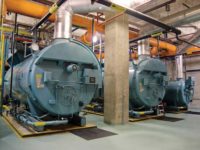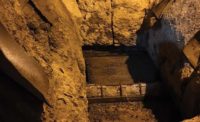CSD-1 is a standard developed by American Society of Mechanical Engineers (ASME) and covers “Controls and Safety Devices for Automatically Fired Boilers.” The previous edition was released in 2018, and the new 14th edition was was issued on Nov. 17, 2021. It was approved by American National Standards Institute (ANSI) on Sept. 9, 2021. Most states have adopted this standard, though some states only use a portion of this standard.
CSD-1 is usually applied to units with inputs up to 12,500,000 Btu/hr and National Fire Protection Association (NFPA) 85 (Boiler and Combustion Systems Hazard Code) is applied to units at or over that input.
Several changes were made to the standard, but most are clarifications and minor wording changes. The items listed in this article are generally considered to be major changes or additions. The information given is in abbreviated form, and the code should be reviewed for the full detail.
Variable Frequency Drive (VFD), CF-1000
Boilers that use VFDs to vary the speed of the combustion air fans shall comply with the following:
a) During prepurge and postpurge, the fan shall provide the full purge airflow;
b) If the VFD is used to modulate the fan speed in response to fuel inputs, the VFD shall respond to the fuel-air-ratio combustion control system;
c) An independent feedback signal shall be used to verify the fan speed;
d) The feedback signal and fuel-air-ratio control shall be labeled and listed by a nationally recognized testing agency;
e) Direct coupled fans may use the motor speed as fan speed;
f) Errors between the directed feedback fan speed shall result in safety shutdown; and
g) VFDs shall not be used where the combustion air fan or motor is used to operate other fuel-burning support equipment, like an oil pump or atomizing air compressor.
Exceptions, CF-1011
a) CFR-1000 does not apply to modulating controls certified as part of boiler units that are labeled and listed;
b) CF-1000 does not apply to ratio-regulator controls; and
c) CF-1000 does not apply to VFD application that do not vary fan speed in relation to firing rate.
This new standard requires that a VFD used to modulate the combustion air fan must do so in combination with the fuel-air-ratio control and must have an independent speed feedback to verify speed. In addition, the fuel-air-ratio control and feedback signal must be listed.
Automatic Stack Dampers, CF-195, Gas-Fired and CF-540, Oil-Fired
When an automatic stack damper is used, the following shall apply:
a) The automatic stack damper shall be labeled and listed for the intended application;
b) A means shall be provided to open the damper to the high fire position before each light off-cycle is initiated and before the prepurge cycle;
c) Dampers shall be interlocked with the burner control system so that the damper is proven to be in the high fire position or full open position during purge. The interlock shall be placed on the driven member; and
d) If a postpurge period is required, a means shall be provided to open the damper to the high fire position or maintain the previous firing position. Dampers used for open-closed function shall maintain the damper in the high fire or full open position during combustion.
In this new standard, an automatically operated damper located in the stack must be listed and provide for a full purge airflow, and interlocked with the burner control. The correct damper position for prepurge and post purge can vary by manufacturer and setup.
Both the VFD and stack damper have direct control of the combustion airflow, and, for safety reasons, should be verified by a third party as suitable for the application. The terms “Labeled” and “Listed” provide additional verification from a nationally recognized testing agency along with continued production inspection.
Remote Shutdown Switch, CE-110
The following additional requirement is added:
For installations not in a boiler or equipment room, such as outdoors on the ground or on a rooftop, the manually operated remote shutdown switch(es) or circuit breaker(s) shall be accessible and located at a safe distance as defined by the authority having jurisdiction.
This was added to cover switch locations with boilers in outdoor installations.
Operational Testing, CG-440, CG-441, CG-442, CG-443, CG-444, and CG-510
CG-440 Operational Testing
The manufacturer and/or installing contractor, as applicable, shall make a testing report available as required.
CG-441 Shop Assembled Boilers – New Installations
Manufacturers shall test and report on the operation of the control system and safety devices. Test conditions shall be as close to field conditions as feasible. Where production makes it infeasible to check each boiler, the manufacturer shall follow a written inspection and quality control procedure.
CG-442 Shop-Assembled Boilers – Existing Installations
After replacing burners or controls, install audible or visual alarms and status or control wiring to the primary flame safety controls. After the boiler unit is moved, the installing contractor shall test and report on the operation of all control systems and safety devices prior to release to the owner/user.
CG-443 Field-Assembled Boilers – New Installations
During commissioning of a new installation, manufacturers, their representatives, or installing contractors shall test and report on the operation of all control systems and safety devices prior to the release to the owner/user.
CG-444 Field-Assembled Boilers – Existing Installations
After replacing burners or controls, or after the burner unit is moved, the installing contractor shall test and report on the operation of all control systems and safety devices prior to release to the owner/user.
CG-500 Certification and Reporting
CG-510 Certification and Reporting
a) Manufacturers and/or installing contractors of shop-assembled boilers shall maintain a report for each boiler unit or for each category; and
b) Manufacturers and/or installing contractors of field assembled boilers shall maintain a report for each boiler unit or category.
This section was revised, with subsections added, to better clarify the reporting requirements. In addition to the above, several new definitions were added to help clarify the meaning of the code.




